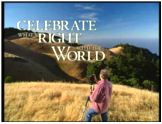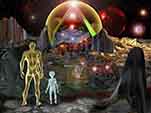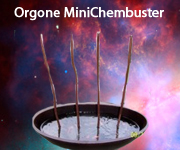By John Elvin
jelvin@InsightMag.com
Once the purview of theologians and devout mystics, the mysteries of death and of the afterlife now are being viewed as legitimate areas for scientific inquiry.
What awaits us beyond death’s door? That ancient question generally is considered a speculative one, a religious or spiritual inquiry suited for mystics, visionaries and seers. But today the same science that brashly is delving into the secrets of life also is probing the mysteries of death. The highly credentialed authors of a recent British study of near-death experiences (NDEs), heralded in the popular press as the first “scientific” study in the field, say they seem to have discovered a “mind” separate from the brain. Whether it is in fact a soul remains a matter of speculation.
Peter Fenwick, coauthor of the study and consultant neuropsychiatrist to several leading British medical institutions, says, “If the mind and brain can be independent, then it raises questions about the continuation of consciousness after death. It also raises the question about a spiritual component to humans and about a meaningful universe with a purpose rather than a random universe.”
Definitions vary but the literature on these matters indicates the classic NDE results from severe trauma and could be described as a transcendental “trip” out of ordinary reality into a special realm where peace and joy are experienced intensely. Closely related and often preceding the NDE is the out-of-body experience (OBE), where a brain-dead or cardiac-arrested patient often believes he or she is present in the operating room as a conscious double, observing events — usually from above.
Fenwick says of the OBE that unconscious, technically dead patients “know what’s going on around them in a way which is very detailed and suggests that the mind may have separated from the brain.” The British study was conducted among serious heart-attack victims because those persons have lost consciousness immediately and gone into a clinical state of death — no respiration, no cardiac output and a nonfunctioning brain stem.
Does this independent mind that seems to survive death have any relation to the religious concept of a soul? Fenwick, asked this question in a recent interview, responded: “We’d be getting close to that.”
The problem for scientists is that the area they are attempting to study, like experiencing religious conversion or other spiritual and mystical sorts of enlightenment, is subjective and defies hard, cold, rational inquiry. Those who undergo NDEs often are barely capable of describing the adventure. Words fail them, and often they are reluctant to attempt a description for fear of being thought crazy.
Browsing the appropriate shelf in almost any bookstore provides evidence of the fringe nature of the core experience, as one encounters offerings including Embraced by the Light, Saved by the Light, Transformed by the Light, One With the Light and Beyond the Light. It is reported that 35 to 40 percent of patients who come close to dying report having had NDEs. Their stories abound in books and in the popular press.
Louis Farrakhan, the recently reclusive leader of the Nation of Islam and a famous firebrand, attributes his new kinder, gentler message of unity and peace to an NDE during treatment for complications related to prostate cancer. Singer Della Reese, star of the TV series Touched by an Angel and an ordained minister, says she encountered angels while at death’s door following a burst brain aneurysm. Others mentioned, at least anecdotally, include Mikhail Gorbachev, Roseanne Barr, George Lucas, Debra Winger and Donald Sutherland.
Contrary to the British “first-ever” claim, scientific studies seeking evidence of life after death actually commenced in the United States some years ago. There is a long track record of the scientific method being applied to this phenomenon, says Carlos Alvarado, a psychologist serving as a program director for the Parapsychology Foundation headquartered in New York City. Alvarado, whose considerable body of published work includes a recent article on this subject in the Journal of Nervous and Mental Disease, tells Insight that researchers in psychology and psychiatry have developed all kinds of methods for studying phenomena that are by nature very subjective — dreams, hallucinations and thought processes that we don’t know how to measure physically.
How are such scientific studies conducted? An example might be a study where subjects are interviewed and then their descriptions related to their oxygen levels while in the NDE state. That would yield certain facts useful from a scientific perspective. But, Alvarado acknowledges, the evidence thus far doesn’t allow us to take the leap into a claim of scientific findings regarding an afterlife. It still is speculation, but it’s a developing field. What we need now is more systematic research and large-scale studies. The British study, he points out, was very small.
The fact that there are common or core experiences — classically, the perception of moving toward a great white light — is well-established. Fenwick and his colleagues cite other common threads: peace and calm, going through a tunnel into another dimension or realm, meeting a being of light and going into a garden. Variations on these themes are found in written and oral traditions as old as human memory.
Also, many who returned from near death believe they experienced a presentation — a “life review” — and others recall fusing with a universal intelligence or consciousness. It is not uncommon that survivors express anger or grief at having been “brought back.” Most survivors lose their fear of death, and many lose interest in financial gain and other aspects of the conventional “successful” lifestyle. Many others feel a general sense of love for other people and are convinced that they have been given special knowledge of the afterlife. As a result of the experience, the lives of most are changed dramatically in a very positive way.
One of the more popular lecturers and writers on the subject is Betty J. Eadie, a mother of eight who tells a touching tale of meeting and talking with Jesus when, at age 31, she died during heart surgery. Eadie, whose early writing on the subject has been disparaged by some colleagues as promotional material for the Mormon church, lectures these days as a generic Christian with New Age overtones. She says she saw angels rushing to answer the prayers of the living. She describes physical handicaps, desperate lives and tragic deaths as aspects of a progression of the spirit. Eadie has a compelling tale, but it is hardly scientific evidence capable of independent confirmation.
Perhaps the most fascinating finding in Insight’s survey of NDE studies is that the physicians, psychiatrists, psychologists and other researchers involved often cross over from their roots in hard science to become bearers of a spiritual, cosmic message. Melvin Morse, for example, links the NDE to a “God spot” in the brain that allows access to timeless and universal realities. Once a total skeptic, Morse now is recognized as one of the leading researchers in the field. He began to take another look when a child who had been through an NDE confronted the researcher’s doubts with the words: “Don’t wo0rry, Dr. Morse, heaven is fun!”
Morse has added substantially to the scientific credibility of NDE research through extensive controlled studies, but his research has put him on a new path. Today he is less concerned with the hard science of his field and far more likely to tell listeners about a spiritual path where “love is all there is.”
The same is true of many other highly credentialed researchers now specializing in NDE and related areas. Raymond Moody, a doctor of medicine and philosophy who has authored several best-selling books, is credited with coining the phrase “near-death experience” back in the 1970s. He is described as “the first medical professional to do work in this area.” Today he devotes a lot of his time to teaching others how to evoke the spirits of departed loved ones. Perhaps his most controversial contribution to the field is the “psychomanteum,” a re-creation of the mirror-gazing process used by ancient Greeks to communicate with spirits. He claims to have introduced more than 300 people to the process and says many of them believe they contacted a dead relative or other spirit in the mirror.
Among other pioneers in the field is Bruce Greyson of the department of psychiatric medicine at the University of Virginia in Charlottesville, editor of the Journal of Near-Death Studies. He also has evolved as a spiritual enthusiast and recently told an interviewer: “What happens [to those who have had an NDE] is that when they lose their fear of death, they also lose their fear of living life to the fullest because they’re not afraid of taking chances anymore. They’re not afraid of dying. So they actually get more interested in life and enjoy it much more than they did before.”
Most of those engaged in NDE research acknowledge the work of psychology professor Kenneth Ring as pivotal in moving their field out of the fringe and into mainstream science. Ring, the author of Lessons From the Light and other books on the subject, is noted for his meticulous, scientifically structured research. But from that foundation he also has ventured beyond the realm of conventional science. When we die, he writes, we go through a second birth, which may be even more difficult than the first, and leave the world we know for another that transcends anything we can conceive. There we discover, finally, what it is to be fully alive and filled with a radiant joy beyond the realm of happiness. He is the founder of one of the major organizations in the field, the International Association of Near-Death Studies (IANDS).
Denise Wade, international spokeswoman for IANDS, had her NDE in 1977. “When I learned that others reported similar experiences, I at first wondered if we are all dreaming the same dream,” she tells Insight. Wade lives in Munich, Germany, but was in the United States recently during an annual IANDS conference. She contends that her experience wasn’t a dream. “It really happened; it changed my life,” she tells Insight.
In Wade’s view, trying to make a hard science of the study of these experiences probably is a waste of time. “It’s anecdotal. You cannot even prove by hard science that there’s a God. I’m more interested in the positive, transforming nature of the experience. The public that is interested in NDEs isn’t asking for numbers; they want to know the nature of their mission on Earth.”
Wade emphasizes: “One is granted the near-death experience from suffering.” She says her experience resulted when she was nearly beaten to death and required an emergency operation that lasted seven-and-one-half hours. She recalls traversing a silver cord toward heaven. “I met spiritual friends,” she recalls, whom she believes guided her through a life review. She came to believe that “we absolutely do have angelic presences that are always, always, watching over us.” Her story is told in the book, The Case for Heaven. What’s the lesson in a nutshell? “It’s all about love,” she says.
Are there no disbelievers? Armies of them, no doubt, but their books and seminars have not seized the public imagination. The average enthusiast, conventional neuroscientists lament, is not overly interested in discussions of brain chemistry and the effects of anesthetics and lack of oxygen on the billions of neural cells working to maintain the balance of the human guidance system. Just as some researchers contend that dreams simply are the effort of the brain to sort and file the day’s activities, so it is suggested that NDEs are just the way the brain processes the approach of death.
The most prominent critic of ethereal interpretations of NDEs is Susan Blackmore, senior lecturer in psychology at the University of the West of England. Author of Dying to Live, she favors the effects of oxygen depletion as an explanation for the broad similarities of the anecdotes, and she terms the reported experiences of life after death an “illusion” based on beliefs and unsupported by physics, biology or psychology. As to the transformative results of this experience, Blackmore says that people tend to become less selfish and more concerned about others after having survived a brush with death. “We are all biological organisms, evolved in fascinating ways for no purpose at all and with no end in mind,” she says.
Blackmore suggests that OBEs are constructed from fragments of memory. The out-of-body view from above, she says, occurs because that’s how memory functions. “Try to remember the last time you went to a pub or walked along the seashore,” she writes, adding that your view of the scene no doubt will be from above. She also observes that hearing is the last sense to go as we lose consciousness, and anyone who has listened intently to a storyteller knows how the mind constructs images to go with the spoken word. So some memories may be constructs based, for instance, on operating-room conversations. Blackmore believes that “trips” similar to NDEs can occur under a variety of circumstances and recounts one of her own induced while smoking marijuana.
Do all experiencers have joyful adventures and return feeling warm and fuzzy? In a research paper published by the Christian Research Journal a few years ago, the author surveyed books covering the “dark side” of these events. The report notes that some NDEs are indeed “hellish” and “terrifying” and that survivors tend to repress memories of them. One book title says much: Beyond the Darkness: My Near Death Journey to the Edge of Hell. The author, Angia Fenimore, tells of her experiences resulting from a suicide attempt.
P.M.H. Atwater, a longtime researcher and author who has experienced the near-death phenomenon and also has made a careful study of the encounters of others, reports that about 15 percent of adults and 3 percent of children enter “a threatening void or stark limbo or hellish purgatory,” sometimes including “hauntings” from the past. She suggests that these experiences often are based on the person’s expectations and psychological predisposition toward guilt, fear and the anticipation of punishment.
Where can science possibly go with this subject? Fenwick, coauthor of the British study, suggests that the next studies should include setting up secret targets in the operating room that could only be seen from the ceiling. That’s the vantage point of most NDEs. Survivors then could be asked to describe what they had seen.
The reaction among religious leaders to what might be regarded as playing games with the soul could be the subject of another entire article. In general, religious leaders take a we-told-you-so attitude toward recent scientific findings in the area. In response to the British study, the bishop of Basingstoke, the Right Rev. Geoffrey Powell, a member of the Church of England’s Doctrine Commission, commented: “These near-death experiences counter the materialist view that we are nothing more than computers made of meat.”
The mystery of death is a subject of intense human curiosity and always has been an area as open to conjuring charlatans and witch doctors as to systematic theologians and devout mystics. But, as this survey has shown, it increasingly is viewed as a legitimate area for mainstream scientific inquiry, stopping just short of government subsidy. It will be interesting to see how science deals with the seductive nature of this issue, especially in view of the way in which many who in recent years have approached it clinically have found themselves giving religious testimony.
The great leap of modern science into the search for the soul is a leap, all right — one that began at the very wellsprings of human musing and yearning.
What It’s Like on the Other Side
Neil Marr, a globe-trotting journalist now based in the south of France, has during a long career with major newspapers and magazines written many stories about survivors of near-death experiences. “I even believed a few of them,” he tells Insight, his skepticism considerably mellowed following his own encounter.
Marr remembers watching over the shoulders of doctors and nurses as they hovered around the bed where his body lay with no heartbeat after a series of five heart attacks. “I was unconscious by the time I arrived at hospital in Manchester, England, and should have had no memory of events from that time until I awoke in the intensive-care unit. But I did.”
Marr recalls the scene in detail, down to the conversations among doctors and nurses. “One of the doctors was a young woman. She never left my side and kept repeating: ‘I’m losing him. … I’m losing him.’ Then she said: ‘I’ve lost him. My fault.’”
He laughs. “I wanted to tell her it didn’t matter,” Marr says. “It was strange how natural everything felt — at peace with the world and everyone in it. I didn’t really give a hoot if I was dead or alive. It was just an interesting experience. Not a worry in the world. Not even that deep-rooted desire for survival.”
His was an out-of-body experience without the mystical trimmings. “There was no ‘heavenly’ feeling with the bright lights, music and mystical figures that some people report after going through this. The prevailing feeling was one of good-natured amusement at all the activity down there around my body. I wanted to tell them to lighten up — that it wasn’t serious.”
Marr was brought back to life by high-voltage zaps from a defibrillator and awoke in a hospital bed, still feeling peaceful and happy. Despite their skepticism, he is certain that he recognized many of the nurses and doctors who had attended him, and especially the pretty young doctor who’d blamed herself. “When I told her not to worry, it hadn’t been her fault at all, she got a bit flustered and said she didn’t know what I meant.”
But she did. “It was a few weeks later when my doctor friend told me, off the record, that the poor kid had been so tired after working 24 hours or more on the trot that she’d made a mistake and given me too much morphine. My heart had stopped.”
Marr attributes his “recall” to the functioning of the senses at a subconscious level, and his feelings of peace and unconcern to the heavy dose of morphine. As for lessons learned, he reflects: “People whose brains might show no obvious sign of activity are not necessarily dead. We may be jumping the gun and diagnosing death too early. Not long ago, with my two brothers and my sister, I had to give the go-ahead to pull the plug on my mother who’d been pronounced brain dead after a failed operation. This research makes you wonder if we weren’t maybe a tad quick off the mark.”
From InsightMag.com courtesy centrexnews.com





































